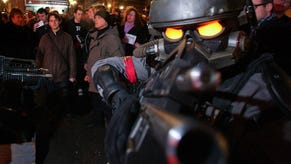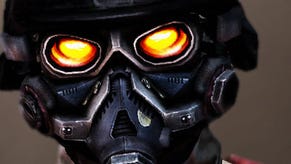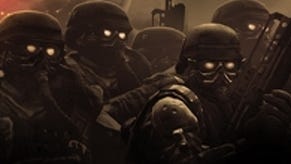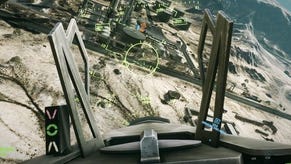Tech Analysis: Killzone 3
Performance, lag and even 3D analysis.
In the midst of gameplay, it is telling just how much more responsive Killzone 3 consistently feels - 33ms might not sound like much, but it can clearly be felt in the controls. That said, it's equally clear that Guerrilla's optimisation effort has gone beyond input latency. The degree of response from the analogue sticks, along with the calibration of the dead zone, has also been retooled from Killzone 2. The result is a sensation that the controls are much lighter than they were in the last game, and there is a period of re-adjustment required to fully get to grips with them. There is still the feel of inertia and "heft", particularly in terms of running and jumping, but there's no doubt that most of the deliberately cumbersome motion from your character is now gone.
The beta code doesn't feature any support for PlayStation Move or stereoscopic 3D, but we have spent some quality time with the E3 demo and played through the exact same content in both 2D and 3D on a state-of-the-art 3DTV. It proved to be an intriguing experience.
Sitting in the audience during the E3 presentation, the main issue we had with the presentation was what is best described as a sort of "diorama" effect, where the 3D is actually more like layers of 2D - view weapon and explosions clearly being in 3D, but still looking rather flat. Away from the auditorium and running on an actual 3DTV, these concerns proved to be far less of an issue. Sure, there was still something "odd" about the explosions and smoke, as if they didn't have true volume, but this was mitigated by the particles, which definitely added an excellent perception of depth. In fact, probably the biggest compliment you can pay to Killzone 3 in 3D is that the immersion level is significantly increased and this adds an intangible "something" to the gameplay.
There's a real sense that you are in an all-out warzone, and an almost palpable sense of panic when the action is at its most intense. 3D is also used in a lot of different, smaller, almost incidental ways too: Rico perched on the Intruder dropship when you use the chaingun is a very nice effect. Similar uses of the third dimension during the cut-scenes are also very nice, particularly the prone Sev regaining consciousness, arms stretching slightly "out" from the screen.
During gameplay, while there is still a sense that the view weapon doesn't quite fit into the overall scene, it does provide one of the (literally) standout moments: switching to iron sights sees the weapon pull forward out of the screen. Very neat, very effective and showy without getting old quickly or looking incongruous. However, claims that the 3D view may aid with depth perception challenges like accurately lobbing a grenade don't really hold much water.
With Killzone 3, it's fair to say that the 3D effect is very real, different and definitely worthwhile, but is it good enough to compensate for the downsides that 3D brings to the table? Does hands-on experience of the actual code tally up with the performance analysis we carried out on the PSN footage? In short, yes. Killzone 3 on a 3DTV in its E3 demo guise operates with a frame-rate penalty compared to the 2D version and it does indeed run at half resolution: 640x718 to be precise, with bilinear hardware scaling used to make up the difference (you can tell this is the case as opposed to using a software solution as HUD detailing is scaled too).
Over and above the lowering of resolution, the biggest problem concerns lower-resolution transparencies, adding a serrated edge to any object influenced by alpha. Transparencies already run at quarter resolution in the 2D version, and having that cut down still further in 3D makes for some ugly moments. Especially on a massive 3D screen, occupying the entire field of view, the trade-offs Guerrilla makes are somewhat visible. However, with any decent compromise what you lose in one respect you'd hope to gain back in another and this certainly applies to Killzone 3D - it definitely offers something worthwhile above and beyond the 2D game. Plus, of course, if you don't like the negative impact, there's nothing stopping you dropping back to the conventional 2D mode.
The E3 demo was is old code now and changes will undoubtedly be made. However, it is fair to say that even in its incomplete state, the experience is eminently playable, and remarkably the frame-rate - while lower - is still within spitting distance of the 2D game for the majority of the time, more so during gameplay than during the cut-scenes. Considering the additional work the PS3 is carrying out in producing a true stereoscopic 3D effect , the tech is remarkable and effective.
We've now spent a good deal of time with two sets of Killzone 3 sampler code: single-player and multiplayer. Overall impressions are positive. Killzone 2 remains one of the most impressive shooters available on PS3, and it's clear that Guerrilla is intent on building upon that significantly. The control elements are effectively fixed, and there are encouraging signs that the developer has actually managed to improve significantly on what was already one of the best-looking games on the machine. Tech-wise, we don't yet see much in the way of a generational leap over what was achieved in Killzone 2 from what we've seen thus far, but certainly there are encouraging signs in terms of art direction and gameplay.
The recent PSN multiplayer beta gives us a good flavour of the online element, but what we've played of the single-player campaign amounts to around 15 minutes of gameplay from just one level - and we are left hungering for more. That March 2011 release date seems so far away.








